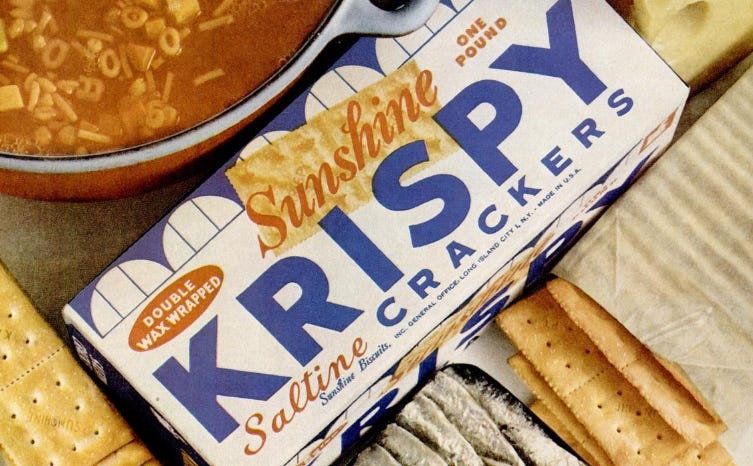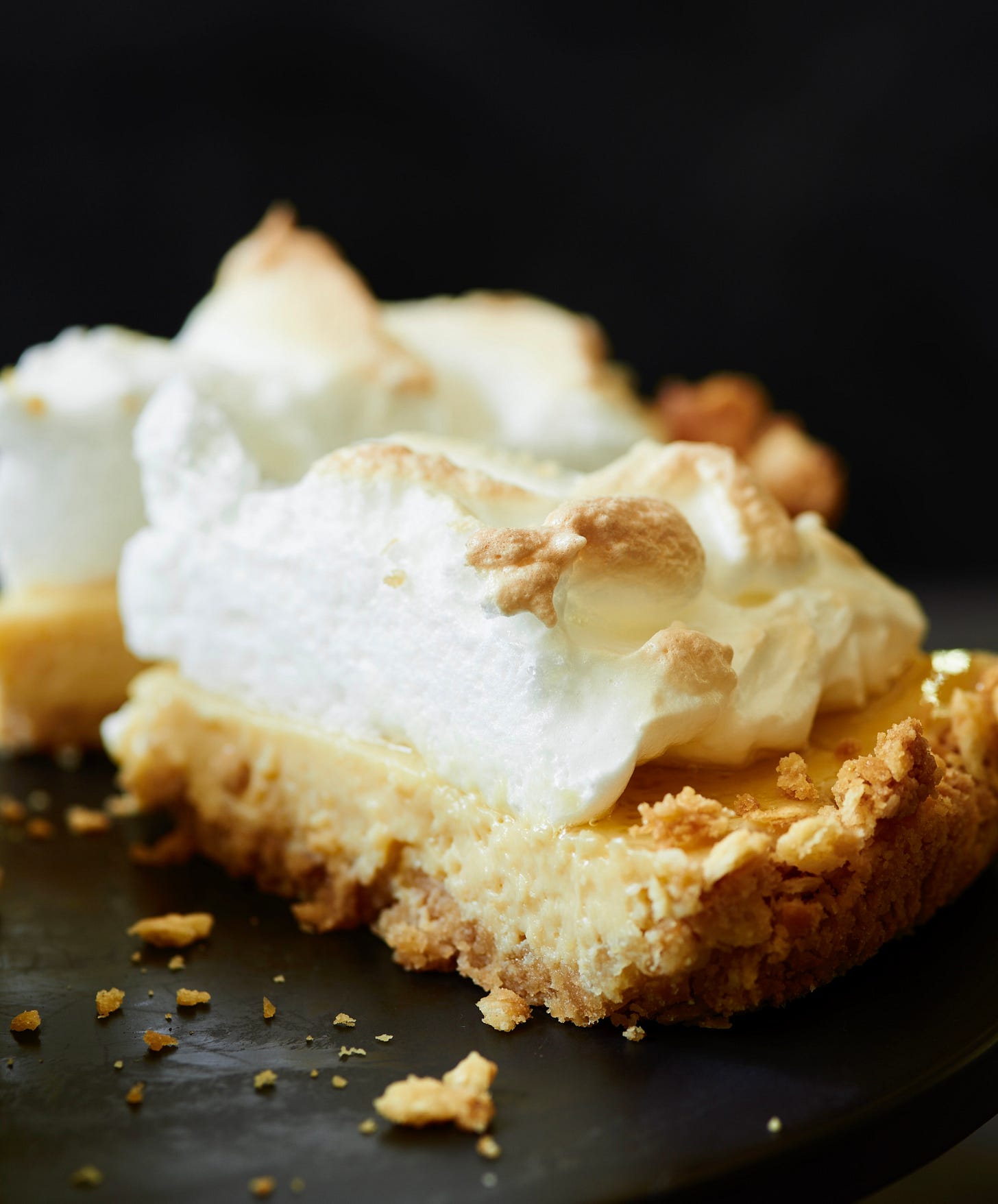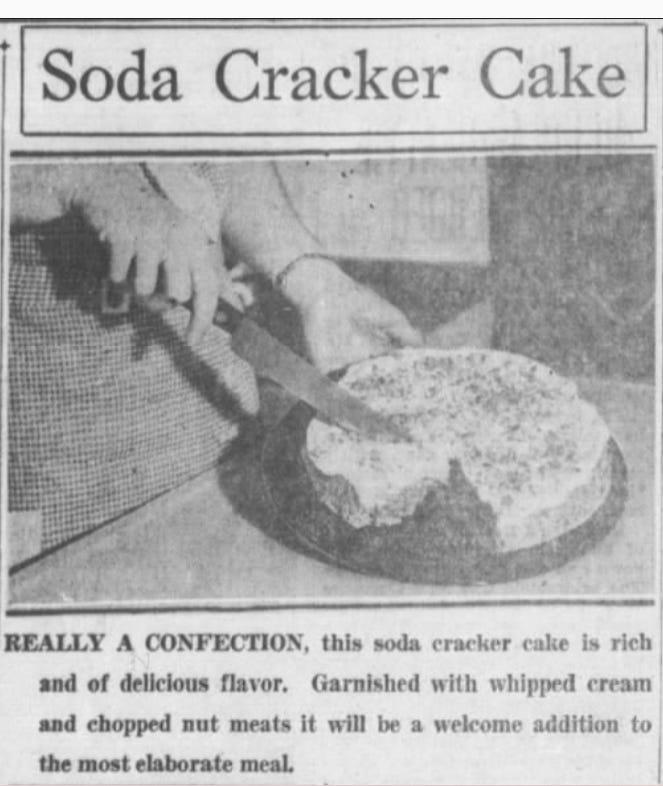The snack that's a secret ingredient
A brief history of baking with crushed crackers
Hello, Snackers. What’s that mysterious flavor? Crackers!
It’s a special edition of Snack Stack today: a collaboration with Anne Byrn, who writes the excellent newsletter Between the Layers. Anne was one of my colleagues in the Substack Food Fellows program (she’s also a bestselling author) and, like me, has an endless interest in food and the story behind it. I’ve enjoyed getting to know Anne through the fellowship and her newsletter, and I know you’ll also have a great time reading her thoughts, insights, and recipes.
Think of this as a delicious two-course meal for your reading pleasure, to be consumed in any order your see fit.
From me, below: the oddly intriguing history of baking with crackers, featuring cakes, pies, and other goodies.
From Anne: a post on a specific kind of cracker-based creation, a sweet, salty, lemony Atlantic Beach Pie, which has its own intriguing story and a saltine crust. Anne also has a recipe for you! Go read Anne’s post here and subscribe to Between the Layers.
Here’s a little preview of Anne’s post
Flip through church cookbooks of the coastal South and along the East Coast, and you will find a lot of lemon pies. Many are like the Key Lime with an uncooked filling of sweetened condensed milk, lime or lemon juice, and eggs. A few might be the frozen icebox variety like my mother made. But the Atlantic Beach Pie is different.
First of all, it’s cooked so you don’t have to worry about serving raw eggs. You separate the eggs, and the yolks go in the filling and the whites are saved for the meringue. Or at least, that’s how I make it. Bill says he tops the pie with whipped cream, which was easier to keep in the fridge at the restaurant and didn’t get weepy like a meringue pie does.
And Bill calls Atlantic Beach Pie “That Stupid Pie” because after it got famous and everyone came into the restaurant asking for it, he could never take it off the menu.
Read the rest. By the way, this is the pie:
And now…
A brief history of baking with crushed crackers
I’ve always thought of crackers as something to eat by themselves, perhaps with a little something on top. Water crackers with a good aged cheddar; Ritz with peanut butter; goldfish straight-up, if my kids are willing to share. It had never occurred to me to put crackers in anything other than soup. But I’m in the minority here, apparently, because if you ask Google for things to make with crackers, you get plenty of results: 39 suggestions from Taste of Home, 16 from Parade, a whole 460 from this Pinterest user.
So when Anne said she was working on a post about pie with a saltine crust and suggested a crossover project, my first thought was, “How much history can there really be here?”
My second thought was, “Well, let’s check the newspaper archives and see …”
And then my third thought, after seeing the long (long) list of results was, “DOUG, THERE’S A LOT HERE! YOU SHOULD HAVE KNOWN THIS! THERE’S ALWAYS A DEEPER STORY TO BE TOLD, AND YOU SHOULD EXPECT THAT BY NOW!”
The basic lesson of Snack Stack is that there’s always an interesting backstory. Apparently I’m still learning this myself.
Let’s dig in.
* * *
Crackers have been around in some form for millennia—The Food Timeline credits “ancient Middle Eastern peoples” with creating the first ones—but it wasn’t until about 200 years ago that they began to become a widespread snack.
“Food historians generally agree that the light, crispy crackers we Americans know today appeared in the 19th century,” says The Food Time. “This coincides with the ‘discovery’ of chemical leaveners such as baking soda and powder.”
At some point in the mid-1800s, as soda crackers spread and evolved, one of these variations was something called a ‘saltina,’ which soon become known as, you guessed it, saltines. The first references to this cracker by this name were around 1873, but exact details are hard to pin down. A guy named Joseph Garneau is often credited with inventing saltines, but like many food origin stories, this one is suspect—Garneau was likely just claiming something that existed already, trying to make a quick buck by boasting that his version was the original. (If you want a lot more history of crackers in the early years of the USA, the New England Historical Society has a long article for you.)
In this same era, as the cracker evolutionary tree was branching and growing, the ways people used crackers were also expanding. What began as a snack unto itself was becoming an ingredient in other, larger dishes. Witness, for example, the first published recipe for mock apple pie, in 1857:
This recipe made the rounds in newspapers for more than 20 years—I found it in archives over and over, into the late 1870s. The substitution of crackers for apples would eventually become a famous Depression-era swap, one that represented the resilience, adaptation, and make-do-with-what-you-have ethos of that era. But according to food historian John T. Edge, the origins of mock apple pie came from a different context altogether:
Review of a selection of older cookbooks and you’ll soon note that, though the National Biscuit Company popularized it [after they introduced the Ritz cracker in 1934], mock apple pie is not remotely newfangled. In her 1881 book What Mrs. Fisher Knows About Old Southern Cooking, Abby Fisher offered recipes for cracker pie flavored with cloves and cinnamon. Similar was the nutmeg-laced recipe in the Confederate Receipt Book of 1863.
Mock apple pie was not, however, a Southern dish born of Civil War deprivation. Among the early advocates was a self-proclaimed California pioneer who, in 1852 when apples sold for a dollar a pound, talked of baking cracker-filled mock apple pies for children “to appease their homesick cravings.”
Edge notes that a cookbook published by White House steward Hugo Ziemann, in 1877, included a recipe for mock apple pie (alongside three variations of regular apple pie), which indicates that, at least for some cooks, the cracker-filled version represented novelty rather than hardship or absence. It was something fun and quirky, the substitution a cheeky delight.
Snack Stack is funded entirely by support from readers like you. It requires many hours of research, writing, and reporting, along with resources like newspaper database subscriptions and books used for research. If you enjoy the newsletter, please chip in to help me continue this work. A paid subscription is just $5 per month or $52 per year, which is a lot less than you spend on actual snacks.
It didn’t take long for cracker-based baking to expand beyond pie. By 1913, newspapers were running recipes for soda cracker and graham cracker cakes (searching “cracker cake” in the Chronicling America newspaper archives, which end in 1963, yields thousands of results).
In 1944, food writer Selena Alig declared “cracker cookery” to be a full-on trend, part of the broader love of convenience:
Cracker cookery is something that’s only happened recently. We women are just now realizing that the contents of the cracker box can save time and points and at the same time turn out delicious victuals. There are oceans of quick tricks.
For instance, try crackers to thicken sauces instead of flour or some other starch. Four crumbled soda crackers or saltines plus a cup of milk, seasonings, and a tablespoon of butter do the trick. Heat together and beat till creamy.
Top your next casserole with a generous sprinkle of toasted crumbs. Or top it with a cracker blanket—whole ones laid side by side—dotted with grated cheese or butter.
… The sweet crackers, graham, gingersnaps, chocolate, vanilla, and lemon, make delicate pie shells. … Sweet crackers also can appear as crumbs in fruit gelatin or sprinkle the crumbs over a pudding before cooling to prevent a skin from forming. Even a cake is possible with crackers!
The original saltine cracker pie crust appears to have entered the culinary landscape around this time, in that midcentury period of home-cooking restlessness and the rise of modern convenience culture. The earliest reference to this type of crust that I could find in print was a recipe for a blueberry-lemon chiffon pie, published in the Salem, Oregon Capital Journal in 1957, and the sentiment of that story echoed others I found from around the same period, like this one on pie crusts made without dough. In short: crackers were a way for restless postwar chefs to mix things up a bit. They were a kitchen hack, both shortcut and a grace note in a handy-dandy box.
All of which is to say: While pie with a saltine cracker crust has its roots in dishes from nearly 200 years ago, this specific dessert is a relatively recent innovation, one that goes back no earlier than the 1950s. It was designed to be a showoff piece, a bit of experimental sweet stuff for your loved ones or guests, with the crackers as a secret ingredient just waiting to be discovered with cries of wonder and delight and perhaps a bit of confusion.
So if you haven’t yet, go check out Anne’s post and recipe—and if you bake it, let us know the results.
Happy snacking!
Thanks for reading! If you liked this, please share it and subscribe. You might also be interested in some recent posts like this essay on food mythology, this investigation of fried ice cream (and Baked Alaska), or this deep dive on the curious history of square-cut pizza.





